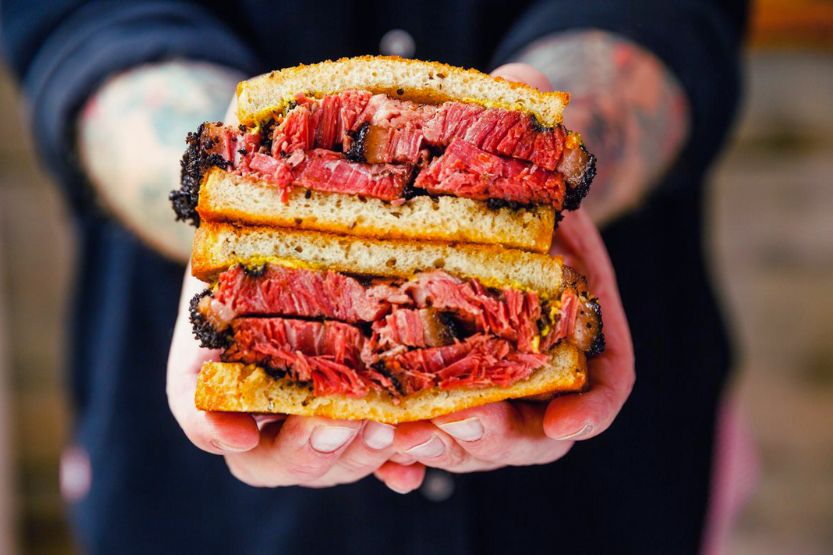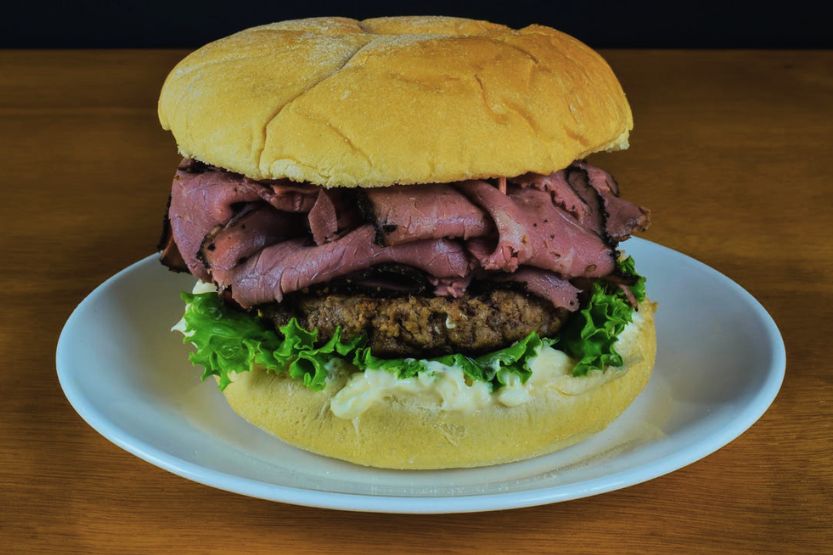The answer might be obvious to most people, but not all people know the answer to this question. Is pastrami beef or pork? If you cannot eat pork or beef due to religious or ethical choices, you should know the components of meat pastrami.
Genuine pastrami is always made from beef. In most cases, it is the beef plate cut, also known as the short plate. However, you can also use the brisket. Many people also often mistake pastrami for corned beef and vice-versa. However, note that pastrami and corned beef have different ways of cooking. You can cook pastrami by smoking, while the corned beef is boiled or steamed.
Read on to learn if pastrami is pork or beef and some more information about this popular deli meat.
Is Pastrami Pork or Beef?

What Is Pastrami Made of?
Traditional pastrami is deli meat made from the beef navel plate. Pastrami is quite spicy as it typically uses a flavorful spice mixture. It usually contains coriander, black pepper, garlic, allspice, mustard seed, paprika, and more.
Pastrami Is Smoked Corned Beef
Many people often mistake pastrami for corned beef and vice-versa. Technically, the pastrami is smoked corned beef.
Corned Beef and Pastrami Use the Same Spice and Brine
Both deli meats usually use the same spice and brine for preparing the meat but are cooked differently. You can smoke pastrami and then steam it. Meanwhile, corned beef often requires boiling.
Process of Cooking Pastrami
Cooking pastrami will usually take an entire day. Making homemade pastrami from scratch will require a lengthy process, including the following processes:
- Brining,
- Rinsing,
- Seasoning,
- Smoking, and
- Steaming.
The brining process is what gives the pastrami its signature spicy flavor. On the other hand, steaming will give pastrami its soft and melt-in-your-mouth texture.
Pastrami’s Reddish Hue Due to the Pink Curing Salt
Although pastrami is already fully cooked, the meat will still have a reddish hue when you cut into it. This results from using pink curing salts in the brine and the smoking process.
Using Pork Will Not Result in a Pastrami
Swapping out the beef navel plate with pork belly and keeping the remaining ingredients the same will not yield pastrami. Pork belly is the equivalent cut for pork.
Because of the cooking process and the pork cut, you will have a spicy side of bacon. This will happen even when you are using the same spices. Also, note that even if it will undoubtedly be delicious, bacon is not pastrami.
A Brief History of Pastrami
Originated from the Ottoman Turks’ Jerky
According to food historians, pastrami originated from the kind of jerky the Ottoman Turks made, called pastirma. Before refrigeration was discovered, the Turkish people would dry and cure their meats using salt.
They would often use goat, mutton, or turkey. After curing the meats with salt, they would then rub various spices on them. This is what will give them a distinct flavor.
Recipe Find Its Way to Eastern Europe
The recipe would then find its way to Eastern Europe via the spice trade. It became quite popular in Romania. The Romanians made the jerky recipe their own and adapted it to use goose meat.
Romanian Immigrants Brought the Pastrami into the US
Pastrami made its way into the US via the Romanian immigrants who settled in New York during the 19th century. Instead of turkey meat, the Romanian immigrants used beef brisket.
Because refrigeration was a staple back then, the immigrants used a weaker brine formulation. They made their version a lot more tender.
New York City Became the Pastrami Capital of the World
Note that New York City was the main destination for most Jewish immigrants during the 19th century. This is the reason why it became the pastrami capital of the world.
It all started with a Lithuanian Jewish immigrant named Sussman Volk. He was a butcher often credited for making the first pastrami sandwich in the US back in 1887.
Volk got the recipe for pastrami from a Romanian friend because of a deal. Volk got the recipe when he offered to keep an eye on his friend’s property. He then started serving pastrami sandwiches out of his butcher shop in 1887.
Volk’s pastrami sandwiches eventually became so popular. He turned his entire butcher shop into a dedicated sandwich shop to keep up with the demand.
Pastrami in Pop Culture
Pastrami is the quintessential deli meat. Almost all movies based in New York City mention it. In most cases, it is when used in a sandwich.
Here are some instances where this legendary deli meat was mentioned in popular culture:
Movie
If you are a movie buff, you may remember that scene in When Harry Met Sally. It is where the titular characters were having lunch at the iconic Katz’s Delicatessen.
However, what most people didn’t notice was that Harry was the one who was eating the pastrami. Sally had a turkey sandwich. However, Billy Crystal admitted that he enjoyed having pastrami sandwiches between takes.
Music
In 1962, The Dartells recorded and released their hit song “Hot Pastrami.” It peaked at #11 on the US pop charts the following year.
Documentary
In 2014, a Deli Man documentary featured pastrami as the central topic.
Reality Show
In the reality show Food Wars, one episode was dedicated to the “Pastrami War.” It has been held in New York for almost a century.
Orson Welles, a famed director, and eternal pastrami fan, said: “There could be no picture-making without pastrami.”
TV Sitcom
In the hit TV sitcom Seinfeld, there was a memorable scene where George Costanza was left speechless. It was when his date declared, “I find the pastrami to be the most sensual of all the salted, cured meats.”
How to Make Pastrami

Anyone can make pastrami. It requires no special skill, and the equipment is easy to source. However, it is a time-consuming task. If you are thinking of making pastrami, make a large batch. There are essentially five basic steps in the pastrami-making process:
- Trimming the meat
- Curing
- Rinsing the meat and rubbing spices
- Smoking
- Steaming
1. Trim the Meat
Use the Navel Plate or Brisket Cut
It will depend on how much you want to trim the navel plate or brisket. Some people like their pastrami lean—meanwhile, others like a bit of fat in their cured meats.
Leave a Bit of Fat
I suggest leaving a bit of a fat cap to keep the meat moist. It will also impart quite a lot of flavors to the final product. It is best to leave a 1/8-inch-thick fat cap on the meat.
Do you want to use a whole brisket? Then trim most of the fat between the flat seam and the point. It will be up to you if you want to keep the muscles together. However, I suggest you do.
It will ensure that the resulting pastrami will have an even thickness throughout and be cooked evenly.
Ask the Butcher to Trim the Meat
Have your butcher trim the meat if you are not skilled with a knife. I recommend asking for the fat trimmings. You can use them to make a killer beef stock later.
2. Curing
After you finish trimming the meat, you can then brine it. You can technically start at this point by buying a slab of corned beef. The reason is pastrami is smoked corned beef. Still, remember that pastrami somehow tastes better if you brine it yourself.
Traditional Brine Recipe
You can use the traditional brine recipe:
- Curing salt,
- Table salt,
- Sugar,
- Pickling spices, and
- Garlic.
However, you can also add some spices that you think would make your pastrami taste better.
Results in a Finer and Softer Meat
Although the meat will be submerged in the brine, the high salt content slightly dries the meat. This will compact the muscle fibers tightly. The result is a finer and softer texture afterward. Place the meat in a plastic container. Cover it with the brine solution.
Allow the Meat Cure for a Week to 10 Days
Cover the container, too, then put it inside the fridge. Give the brine ample time to cure the meat and impart its flavors. Around a week to 10 days should be long enough.
Nitrites Present Give the Pastrami Its unique Flavor
The nitrites present in the brine give the pastrami its unique, slightly sharp flavor. When the nitrates react with the meat, it forms nitric oxide.
This is a substance that helps prevent the oxidation of fat, preventing it from going rancid. This is the same reaction that gives pastrami its signature bright pink color.
Again, is pastrami pork or beef? Pastrami is a smoked beef navel plate. Before the smoking process, the meat has been seasoned with spices, such as garlic, coriander, black pepper, mustard seed, allspice, and cloves.
3. Rinse the Meat and Rub on the Spices
Rinse the Meat Under Running Water
After a week in the brine solution, rinse the meat under running water. This will ensure that the resulting pastrami will not be too salty. Rinse the brisket for around 5 minutes and then dry it with paper towels.
Place the meat on a rack and then apply a liberal amount of your choice of spices on all sides.
Spice Rub Recipe
Here’s a simple spice rub recipe that you can try:
- 4 tbsp cracked black pepper
- 2 tbsp coriander powder
- 1 tbsp brown sugar
- 2 tsp garlic powder
- 2 tsp onion powder
- 1 tsp mustard powder
- 1 tsp smoked paprika
Avoid Adding More Salt
Mix all the ingredients in a bowl and then rub them all over the brisket. By now, this is technically raw corned beef. Add more spices if you want, like juniper berries or chili flakes. Just avoid adding more salt. The reason is that the meat already has plenty of salt in it.
4. Smoking
Corned Beef Is Braised in a Flavored Stock Until Tender
The main difference between pastrami and corned beef begins at the smoking stage. You must braise corned beef in a flavored stock until it is tender.
Pastrami Is Smoked for Added Flavor
Meanwhile, pastrami must be smoked to impart that lovely wood smoke flavor to the meat. Set your smoker to around 250°F and smoke the brisket for at least 4 hours.
Use Mild-flavored Wood Smoke
You don’t want to use strong wood flavors like mesquite or hickory when smoking pastrami. The reason is that they might overpower the spices. Use mild-flavored wood smoke instead. Some popular choices include apple, cherry wood, and maple.
Ensure the Smoke Is Not Too Hot
Ensure that the smoke is not too hot. The reason is that it will only dry out the meat too fast. You want to simmer the beef and get as much flavor as possible. In addition, you will not be finishing the cooking process of the pastrami in the smoker.
Finish Smoking When the Internal Temperature Is 150°F
You need to get an internal temperature of around 150°F. If you hit the right internal temperature, but the “bark” has not been set up, turn the temperature up a notch. Let it go for another 30 minutes or so.
Let the Meat Cool Down
After smoking, you can head on over to the next step. However, let the brisket cool down to room temperature if you want. Wrap it in foil and put it in the fridge. It will still taste the same regardless.
5. Steaming
Gently Cooking the Meat Will Retain the Moisture
The brining process drew out quite a bit of moisture from the brisket. This is the reason why you need to steam it. That way, it will gently cook the meat while retaining moisture.
Use a Traditional Stovetop Steamer
You can use a traditional stovetop steamer. Alternatively, you can place it on the middle rack of the oven with another baking dish with water underneath it.
Allow the Pastrami to Reach At Least 203°F Internal Temperature
Allow the steam to cook the pastrami thoroughly. It should be until it reaches an internal temperature of at least 203°F, but no more than 275°F. The steam’s slow and gentle heat will allow the brisket’s connective tissue to soften. This will also make it turn into gelatin.
Allow the Meat to Rest for Half an Hour
After steaming, do not cut into the pastrami just yet. Let it rest for half an hour to let the juices settle into the meat. Once the pastrami has cooled down enough, you can proceed to slice it thinly and serve.
Pastrami vs. Corned Beef – Similarities and Differences

Is pastrami corned beef? Although these two deli meats look almost identical, they are quite different from each other. Here are some of the similarities and differences between pastrami and corned beef.
Countries of Origin
Pastrami came from Eastern Europe. Historians say that pastrami can trace its ancestry back to the Ottoman Empire, from a dish called “pastirma.”
When it made its way to Eastern Europe, namely in Romania, it became “pastrama.” It is usually from mutton or goat. Corned beef can trace its origins to Ireland. This is why it is a staple fare during St. Patrick’s Day.
Different Cuts of Meat
Although corned beef and pastrami are from beef, they use different cuts. Corned beef is usually from the brisket around the cow’s upper abdomen.
Meanwhile, the pastrami is from the navel plate. You can find it just below the ribs of the animal. It is more tender. However, some delis also use brisket for their pastrami.
Same Brine
Pastrami and corned beef are both brined. This means you can marinate them in a salty and spicy solution for a couple of days. Although different recipes use different spices, they share the same basic flavor profile.
Pastrami Gets a Spice Rub
After lounging in brine for a week, the beef for pastrami gets a coating of different spices. On the other hand, corned beef gets nothing. It just gets a good rinsing and then patted dry.
Different Cooking Methods
It is crucial to smoke pastrami slowly using hardwood chips for a couple of hours. Do this until it develops a nice “bark” around the meat.
After smoking, steam the pastrami to cook and make the meat more tender. As for the corned beef, you must boil it plainly after the brining process.
Frequently Asked Questions (FAQs)
Can You Use Pork to Make Pastrami?
Technically, you can use pork as a replacement for beef in any pastrami recipe. However, you cannot call the resulting product pastrami.
If New Yorkers hear you say “pork pastrami,” they will give you a piece of their mind, guaranteed. Meanwhile, you will still get a delicious smoked meat product, but it is not pastrami.
Should You Only Use Beef Navel Flats for Pastrami?
Although it is preferable to use the navel flat cut, you can use other cuts of beef to make pastrami. Most people prefer the navel cut or brisket as it has just the right amount of marbling. It is also cheaper.
Is Pastrami Halal or Kosher?
Since pastrami is beef, it is already technically halfway to being halal. It will then depend on where you get your pastrami from.
Ensure that they process the meat using halal standards. And yes, you can buy pastrami from any kosher deli restaurant. It is still regular pastrami but uses kosher-certified ingredients.
In Closing – Is Pastrami Pork or Beef?
It is always from beef if you are talking about genuine pastrami. It is from the beef navel plate, also known as the short plate. Note, though, that you can also use brisket. Because they look almost identical, people often mistake pastrami and corned beef for each other.
However, you can cook them in different ways. Pastrami requires smoking and then steaming, while corned beef requires boiling. You can technically replace beef with pork in any pastrami recipe, but you cannot call it true pastrami. You will still get a delicious smoked meat product, though.
Read next:



![Read more about the article How Long to Boil Chicken Breast? [Boneless, Bone-In, and Frozen]](https://howchimp.com/wp-content/uploads/2020/10/how-long-to-boil-chicken-breast-300x200.jpg)